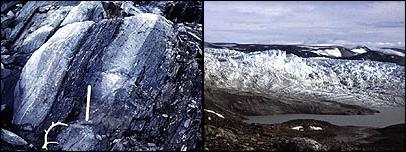Scientists claim to have found the oldest evidence of photosynthesis - the most important chemical reaction on Earth - in 3.7 billion year old rocks.

Scientists claim to have found the oldest evidence of photosynthesis - the most important chemical reaction on Earth - in 3.7 billion year old rocks.
Photosynthesis is the process by which certain plants, algae and bacteria convert sunlight into chemical energy.
Danish researchers say that rocks from Greenland show that life forms were aided in the process about a billion years earlier than thought.
The details of the research are published in the journal Earth and Planetary Science Letters.
Professor Minik Roesing and Professor Robert Frey of the University of Copenhagen, Denmark, analyzed ancient sediments from the seabed in Isoa, Greenland, where they previously found the earliest evidence of life on Earth.
"This shows that Earth had a functioning biosphere about 3.7 billion years ago," Professor Rosing told BBC News Online.
The researchers discovered significant amounts of the element uranium in the ancient sediments, which apparently came from ocean waters.
In a "poor" environment where little or no photosynthesis occurs, the elements thorium and uranium will circulate in the ocean water together as mineral particles.
The high abundance of uranium relative to thorium in rocks from Isua suggests that the uranium was chemically separated from the thorium.
This occurs under "oxidizing" conditions, when the plants release oxygen into the environment.
Rosing and Frey concluded that microbes, similar to today's cyanobacteria, converted sunlight into chemical energy through oxygenic photosynthesis, photosynthesis that produces oxygen.
It is estimated that non-oxidic photosynthesis, a type of reaction that does not produce oxygen as a by-product, developed before oxidative photosynthesis.
Professor Rosing does not dispute this, but he said: "The problem is that you cannot tell how long life evolved 3.7 billion years ago. The geological record more or less stopped there."
Professor Michael Bickel, a geologist from the University of Cambridge in England, said that the existence of photosynthesis 3.7 billion years ago was not in doubt.
Roger Buick, however, an associate professor of astrobiology at the University of Washington in Seattle, US, was cautious about the findings.
"Anything at such an age is a bit questionable. These rocks have been put through the geology grinder too many times - it would be hard to testify that what you see is ancient," he said.
Despite this, Rosing claims that isotopes of lead in rock preserve a kind of precise "isotopic memory" of the composition of uranium and thorium in the past, thus suggesting that the values of the isotopes are ancient, or real.
"Minnick Rosing knows [the rocks of Isua] better than anyone. I don't doubt his information for a moment, I just wonder how strong the interpretation of this information will be," Dr. Boyke added.
Studies conducted by Boyk on rocks from the Pilbara, Australia, established photosynthesis 2.6 - 2.7 billion years ago. However, the latest findings place the date about a billion years earlier.
"The biochemistry, which needs oxygenic photosynthesis, needs a lot of bacterial evolution. If their findings are correct, life on Earth was very complex in the very early stages of history," Boyke said.
For about 750 million years after its formation the Earth was bombarded with meteors. This bombardment ended only about 3.8 billion years ago.
"You might think that these conditions would be quite hostile to oxygenic photosynthesisers, but life may be older and more robust than we thought."
